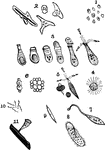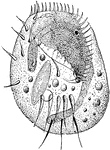Clipart tagged: ‘infusoria’

Forms of the animalcules, magnified
"Fig. 1, Monads; 2, Forms assumed by the Ameoba; 3, Flask Animalcules, Enchelis; 4, Actinophrys sol;…

Flagellate Infusoria
Infusoria is an obsolete collective term for minute aquatic creatures like ciliates, euglenoids, protozoa,…

Infusoria
Infusoria is an obsolete collective term for minute aquatic creatures like ciliates, euglenoids, protozoa,…